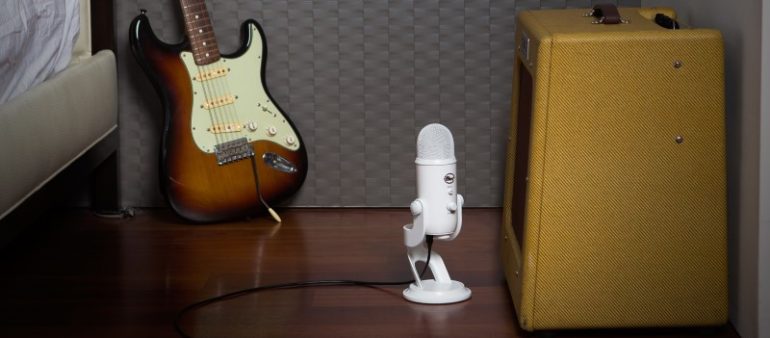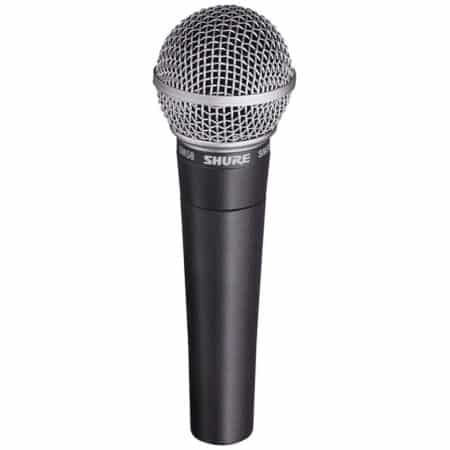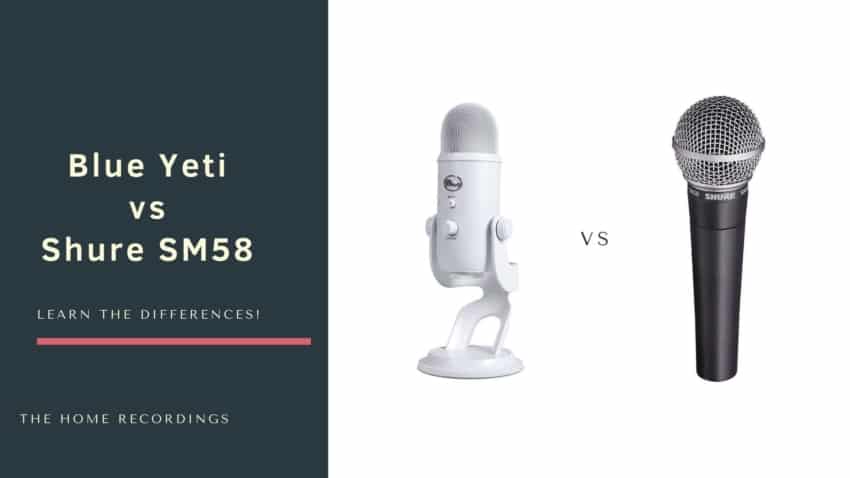Last updated on December 29th, 2023 at 09:58 pm
The Shure SM58 and the Blue Yeti are two of the best-known microphones out there today, and even though they are VERY different and don’t fulfill the same needs at all, I heard so many people asking about the differences that I decided to write an article about it.
Here you will learn about the basic differences between the two microphones and which one you should choose depending on your needs.
Just remember that they are VERY different…
So, with that in mind, let’s get started!
Differences between the Blue Yeti and the Shure SM58
The Blue Yeti is a USB microphone that has three condenser capsules in it, and this allows it to switch between four different polar patterns; Cardioid, Omni- & Bi-directional, and Stereo.
The Shure SM58 is a Dynamic Cardioid microphone designed mostly for singing, and since it is an XLR Mic it needs additional equipment to work, such as an Audio Interface.
Both microphones are completely different and serve a whole different purpose; The Blue Yeti, since it’s a USB mic, connects directly to your computer, and this means that recording more microphones simultaneously will be nearly impossible.
Because of the different pickup patterns, it ends up being more versatile in a sense, because it can be used to record nearly anything, such as podcasts, YouTube videos, singing, acoustic guitars, you name it.
The Shure SM58, on the other hand, was designed mainly to be used as a vocal microphone, which is why it’s got a cardioid pickup pattern and a built-in pop filter, plus the handling noise is quite minimal.
Lastly, the SM58 has XLR connectivity, and this means that the audio signal will be much cleaner and free of unwanted noises, yielding a better end result, but more on this in a bit!
Now, let’s have a quick look at both of them!
Blue Yeti

Even though Blue is mostly known for their High-end ultra expensive microphones, they also came up with the Blue Yeti, which is an affordable USB microphone, and in fact it’s the best-selling one on the market right now.
The Blue Yeti will work perfectly both on Windows and Mac OS and it’s a plug and play mic, which simply means that once you connect it to your PC, that’s it! It’s ready to be used without having to install any drivers.
The build quality is great, it feels very durable and not flimsy at all; it should last you a very long time if you take care of it.
It features a multitude of pickup patterns like cardioid, omnidirectional, stereo and bidirectional, which makes the Blue Yeti a lot more versatile than most other USB microphones, since usually they only feature a cardioid polar pattern.
It is not only a good microphone for podcasters, YouTubers and Voice-over artists, but it’s also pretty good for recording music… emphasis on pretty good.
This microphone also comes with a Gain control, mute button and a zero-latency headphone output, which is on the bottom.
I compared the Blue Yeti to the AT2020 USB and having easy to use knobs is something that one would take for granted, right? But with the AT2020, even though I think that it’s a better-sounding mic, setting the levels is a bit harder.
The reason the Blue Yeti is a good option for recording music is, apart from its good sound quality, that it can record in stereo.
Why is the stereo pattern so useful?
We usually record acoustic guitars, pianos, etc. using two pencil condenser microphones which, when combined, give us some of the best sounding stereo recordings available.
While the Blue Yeti won’t give you the exact same results as the two pencil microphones, it may give you a better result than most cardioid microphones out there simply because it’s a stereo recording, especially since a mic like the SM58 doesn’t do that great of a job at recording acoustic guitars.
Another plus is that if you already own a cardioid microphone, you can use the omni setting on the Blue Yeti and record with both of them at the same time using the mid-side technique, which is an excellent way of creating a stereo recording.
However, there is one issue with this that is that using two USB microphones simultaneously isn’t that easy.
How does it Perform?
The Blue Yeti is very easy to use and doesn’t require any technical knowledge to be configured; just connect it to your PC and use it, without the need to worry about any drivers or latency.
The sound quality is very good considering the price, plus having four different pickup patterns allows for a lot of versatility, although I don’t really think you will ever use any other pattern except for cardioid.
Do you need to record a bunch of people for a podcast? Or do you need to record and ensemble? Or maybe you just want it to have a conversation over skype…
With all of these pickup patterns you can easily do all of this without any issues.
I liked it especially for voice-related applications but not so much for recording music.
This is because even though the stereo pickup pattern can come in handy when recording something like an acoustic guitar, I just didn’t like the way it sounded as much; It doesn’t sound as bright as I would have hoped.
That’s why I said that it sounds “good” and not “great”.
What comes in the Box?
- The Blue Yeti Microphone
- USB Cable
Features
- Tri-capsule array: three condenser capsules inside
- Multiple pattern selection: cardioid, stereo, omnidirectional and bidirectional
- Gain control, mute button, zero-latency headphone output
- Perfect for podcasting, voiceovers, game streaming, interviews, conference calls and music recording
- Plug ‘n play: Mac and PC compatible
- Desk stand included (already attached to the mic)
Specifications
- Polar Pattern; Cardioid, stereo, omni- and bidirectional
- Frequency Response: 20Hz- 20kHz
- Sample Rate: 48kHz/16-bit
- Max SPL: 120dB
- Weight: 1.2 lbs
If you’re looking for a versatile USB microphone, then it might be a good idea to go for the Blue Yeti.
Two other great alternatives would be the AT2020 USB or the Samson G-Track Pro.
Find out more about the Blue Yeti here.
- Blue Yeti: Amazon, Sweetwater.
Shure SM58

The Shure SM58 is the Nr.1 vocal microphone in history for live shows, studio sessions, live speeches, you name it.
There are actually four different versions of the SM58;
- SM58-CN (Cable included).
- SM58-LC (Cable not included).
- SM58S (On/Off Switch included).
- SM58-X2U (With XLR to USB adapter).
Which one you prefer totally depends on you, but the quality of the mic will be exactly the same no matter which version you choose.
The reason that the SM58 is considered to be one of the- of the best vocal mic in history is because of how reliable it is and its excellent sound quality.
Not only that, but it’s extremely affordable.
It is, essentially, the identical to the Shure SM57 (here’s a link to an article I wrote comparing the two), with the only difference being in the grille.
The SM58 comes with a ball grille that acts like a regular pop filter, allowing it to be used on live shows and reducing the number of plosives significantly.
In fact, if you look at any recording of a live show of almost any artist, more likely than not they are singing into an SM58.
How does it perform?
As far as live sound goes, it’s a fantastic microphone, especially considering that it sells for roughly $100.
Of course, it all depends on the singer, since you need to use a mic that compliments their voice as much as possible, and sometimes the Shure SM58 might not be the best fit.
An alternative would be the Sennheiser e835, which is a similar microphone in every way, but it may fit certain singers better.
If you’re interested in a comparison between the Sennheiser e835 and the Shure SM58, make sure to check out this post I wrote.
But the Shure SM58 generally helps the vocals to sit properly in the mix without too much effort, which is certainly important for live applications.
As far as recording instruments, it’s great for recording electric guitar- and bass cabinets; However, I’d recommend the SM57 for these applications since it was specifically designed for this.
As far as recording acoustic instruments, I have to say that I didn’t like it as much and I’d highly recommend getting a condenser mic for that, like the AT2020 or Rode NT1-a.
Features
- Most famous vocal microphone in the world
- Perfect for studios and live shows
- The grille acts as a pop filter
- Built like a tank
Specifications
| Polar Pattern | Cardioid |
| Microphone type | Dynamic |
| Frequency Response | 50 to 15,000 Hz |
| Output Impedance | Rated impedance is 150 Ohms (300 Ohms actual) |
| Connector | Three-pin (XLR), male |
| Sensitivity | -57.5dB |
Find out more about the Shure SM58 here:
- Shure SM58: Amazon, Sweetwater.
Sound Quality
I mentioned in the beginning that XLR cables have a huge impact on the quality of the sound and shouldn’t be ignored.
The reason for this is that they reduce the interference being picked up by the cable by flipping the polarity of the signal, let me explain quickly:
An XLR cable has three wires in it; Ground, Positive and Negative. When the signal is fed to the cable, the negative signal wire inverts the signal and now two identical audio signals are travelling through the cable out of phase with each other.
Any outside interference picked up by the cable will be in phase, while the audio signals are out of phase.
Now, when the signal reaches the end of the cable, it gets reverted back in phase, but now the outside noise is out of phase, basically cancelling itself out.
This is why XLR cables can be super long and still provide a clear audio signal.
USB cables on the other hand, will pick up some noise.
Which one should you choose?
Well, these microphones are COMPLETELY DIFFERENT, plus the Blue Yeti doesn’t need any additional gear, while the SM58 does, so take that into account since it will add to the overall price tag.
If you don’t already have an Audio Interface and you just need a simple way of recording audio, say for Voice-Over work, YouTube videos, etc., then the Blue Yeti might be what you need since it’s really easy to use.
On the other hand, the SM58 is just a better microphone that is designed to do one thing only, which is recording high-quality audio in a cardioid pickup pattern, mainly vocals, plus it can be used live.
If you are a musician, then definitely go with the SM58 and get an Audio Interface if you don’t have one already.
If you are a beginner who just wants a microphone that is versatile and simply works, then go with the Blue Yeti.
Conclusion
For anyone who is seriously interested in audio, you should definitely work towards purchasing an Audio Interface or Mixer and XLR microphones.
XLR microphones are much better than USB ones for a couple reasons; There are way more models to choose from, they use XLR cables which provide a cleaner signal, and you can get a better microphone for the same price.
I hope this information was useful!
Have a wonderful day!
